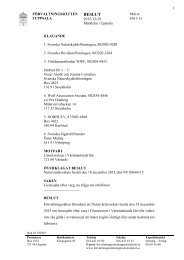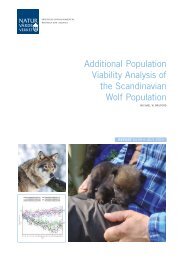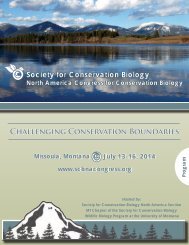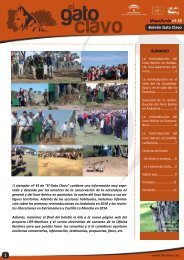1oC3Dbk
1oC3Dbk
1oC3Dbk
Create successful ePaper yourself
Turn your PDF publications into a flip-book with our unique Google optimized e-Paper software.
dimension approach with solid ecology, to bring both science<br />
and management experience to bear on the issues of large<br />
carnivore conservation, and to transfer this expertise into the<br />
policy arena at European level.<br />
In 2013 we updated the information on number,<br />
distribution, trends and status of the European bear, wolf, lynx<br />
and wolverine populations, and produced new detailed<br />
distribution maps by country and by population, more details<br />
here. We held our annual group meeting in Italy in March 2013,<br />
and we approved a Manifesto for large carnivore conservation<br />
in Europe. This is a manifesto of how the LCIE think large<br />
carnivore conservation could look in a European context. It is<br />
intended to inspire, by outlining some long term objectives and<br />
stretch goals which will often go beyond the minimum<br />
standards required by international legal instruments. It states<br />
some principles and recommendations of the measures<br />
needed to achieve these objectives. Perhaps most importantly<br />
it is intended to explore in greater detail the potential<br />
relationship between people and large carnivores in the<br />
landscapes that they share.<br />
We continued our fruitful close collaboration with the<br />
European Commission and we are now engaged on three key<br />
tasks to be completed by the end of 2014:<br />
a) to design and implement an EU-wide communication strategy<br />
on large carnivores that will include website material, press<br />
articles in all major EU languages, support to the Commission<br />
on communicating a new EU platform on carnivore<br />
conservation.<br />
b) to produce a list of the most important conservation actions<br />
to be implemented in each of the EU carnivore populations (10<br />
lynx populations, 10 for wolves, 10 for bears and one for<br />
wolverines),<br />
c) design and implement four pilot conservation actions (one for<br />
each species) at the level of transboundary populations: these<br />
pilot actions will demonstrate the feasibility of transboundary<br />
collaboration in Iberia, the Alps, Fennoscandia and the<br />
Carpathian mountains.<br />
As part of our engagement with the European Commission, in<br />
December 2013, we supported the Commission in managing<br />
the second European Stakeholder meeting on humancarnivore<br />
coexistence.<br />
Lobaria pulmonaria. © C. Scheidegger<br />
Global Fungal Red List website. A project on population biology<br />
and conservation measures of the model lichen species Lobaria<br />
pulmonaria in Tanzania has been initiated, and is being<br />
supported by a Rufford Foundation Small Grant.<br />
We gratefully acknowledge the support of the Mohammad bin<br />
Zayed Species Conservation Fund and the Rufford Foundation.<br />
Christoph Scheidegger and Olga Nadyeina<br />
Co-chairs, Lichen Specialist Group<br />
Macaronesian Island Plants Specialist Group<br />
Our main objective is to make conservation biology tools widely<br />
available; encouraging good diagnostic studies to correctly<br />
catalogue Endangered species (including information on<br />
taxonomy), and promoting recovery actions through Recovery<br />
Plans for macaronesian plants. In this sense, some members of<br />
the Specialist Group have been implementing several ways of<br />
diffusing this knowledge; through contributing to Symposia;<br />
preparing Red List assessments (focusing on Habitats Directive<br />
species) and assisting the administration to encourage the<br />
monitoring of plant species.<br />
Sideritis marmoreal – an endemic of the island of La Gomera (Canary<br />
Islands). © Ricardo Mesa<br />
Luigi Boitani<br />
Chair, Large Carnivore Initiative for Europe<br />
Lichen Specialist Group<br />
The mission of the Lichen Specialist Group is to promote the<br />
study of lichen diversity, population dynamics and conservation<br />
genetics, in order to evaluate the conservation status of lichen<br />
species according to IUCN Red List criteria. We have<br />
established a group of 23 members, who are specialists in<br />
either regional floras (Europe, Asia, Africa, Australia, North and<br />
South America), or in ecological and taxonomic groups of<br />
lichens (like tropical lichens, arid lichens in steppe ecosystems,<br />
European deciduous forest lichens, Caucasian lichens, or<br />
lichens of the family Parmeliaceae).<br />
In 2013, we contributed to the Global Fungal Red List<br />
Initiative, which was kindly supported by IUCN and the<br />
Mohammad bin Zayed Species Conservation Fund. We have<br />
started IUCN Red List assessments for a considerable number<br />
of lichen species from various parts of the world, using the<br />
Specialist Groups, Task Forces and Red List Authorities<br />
65






